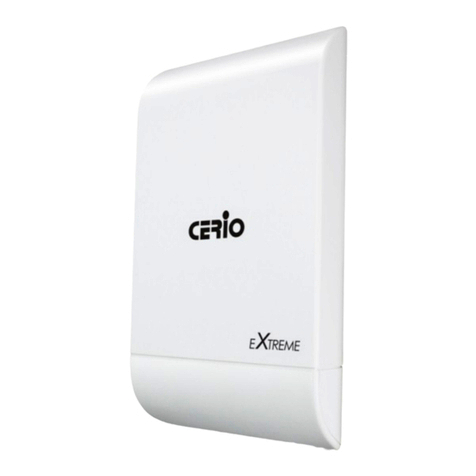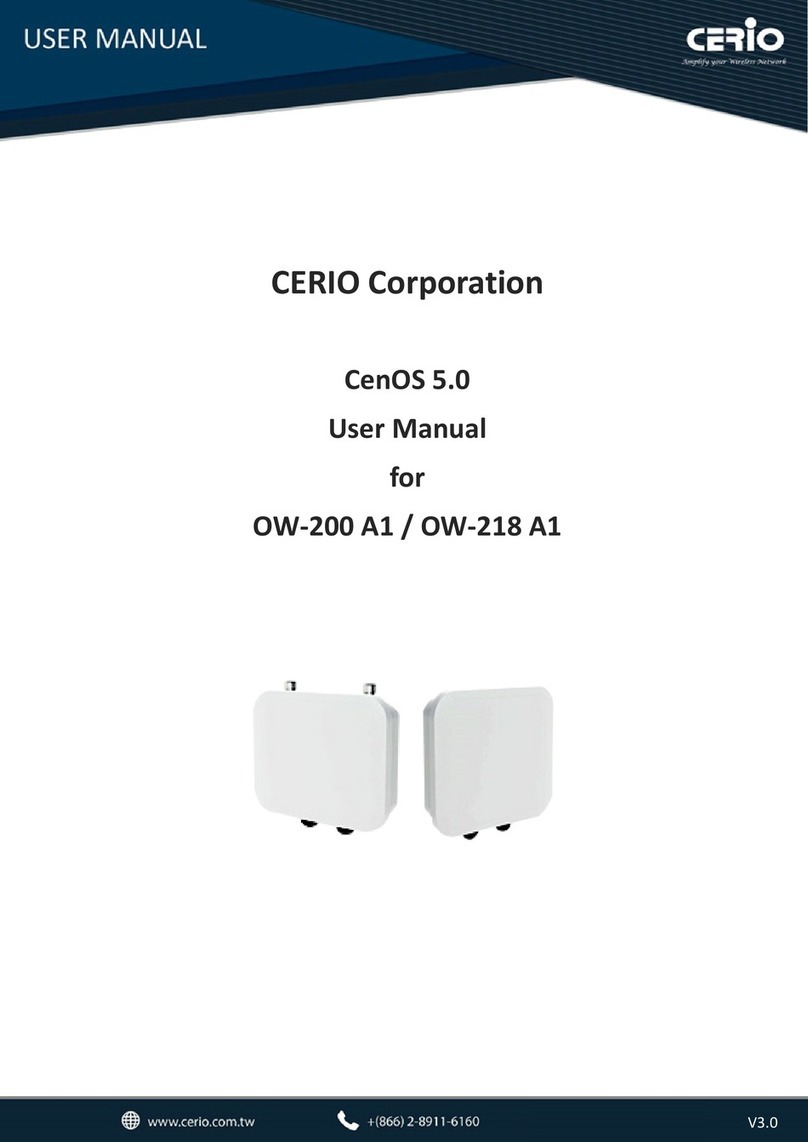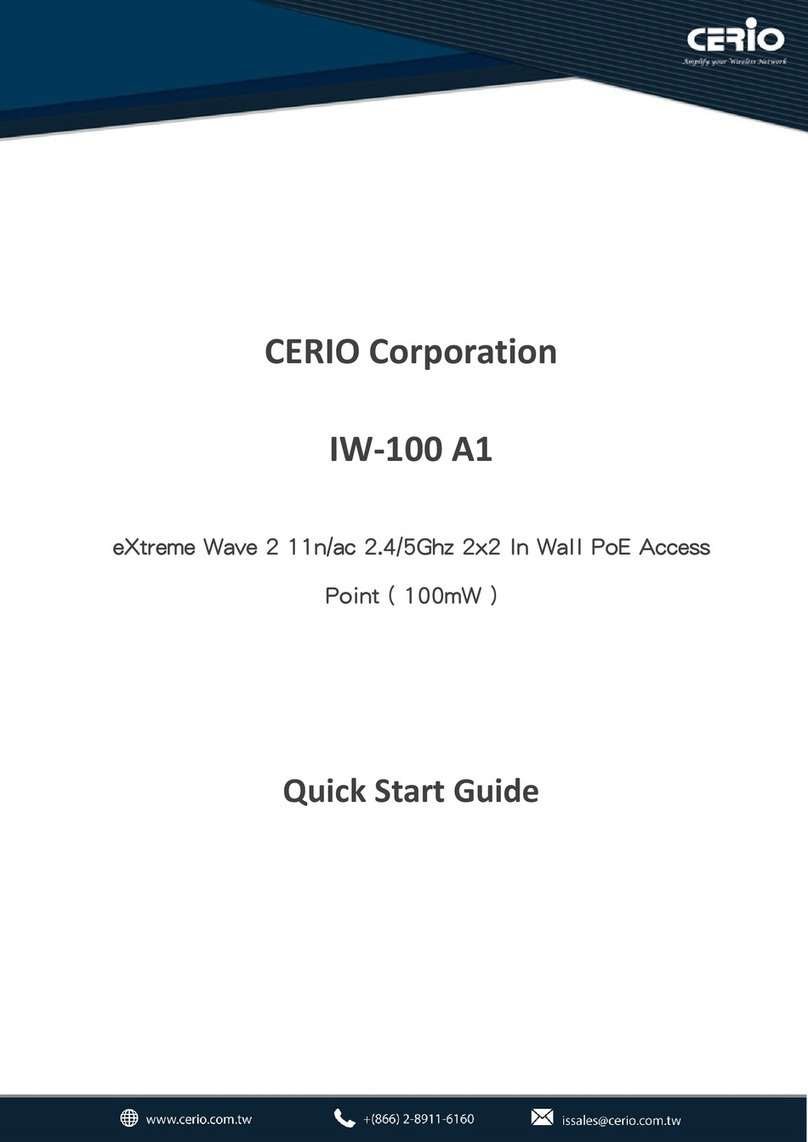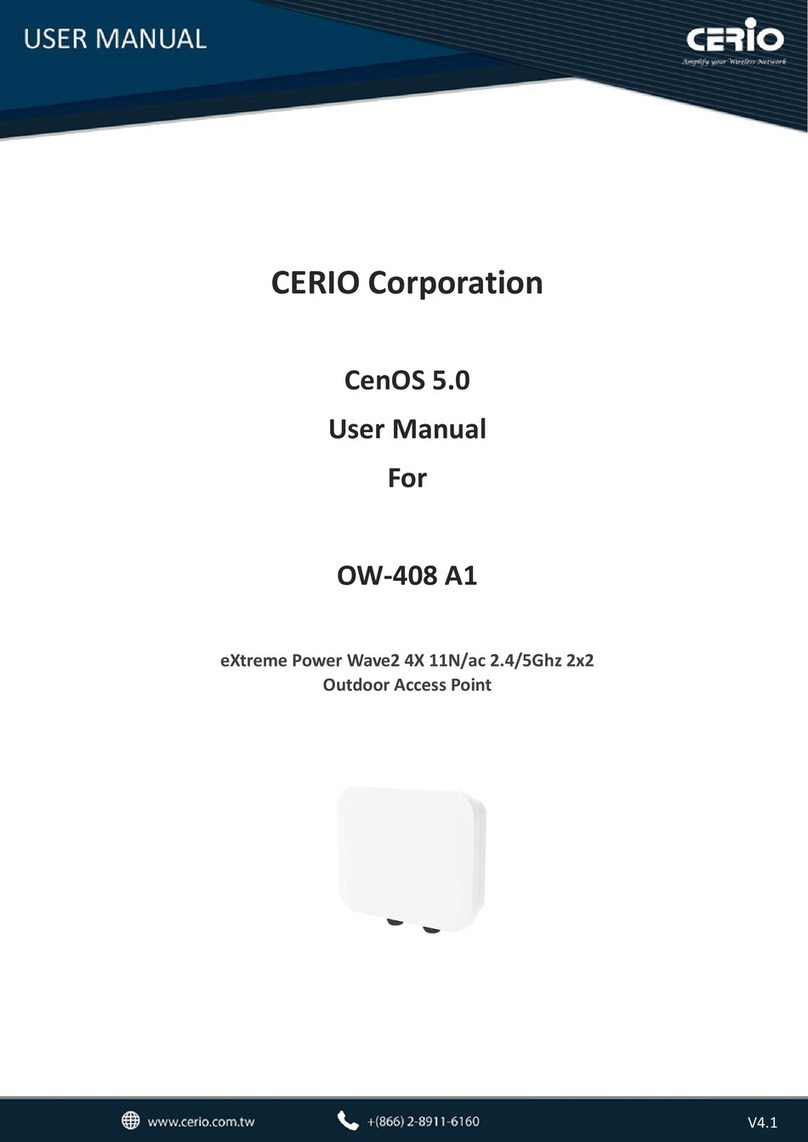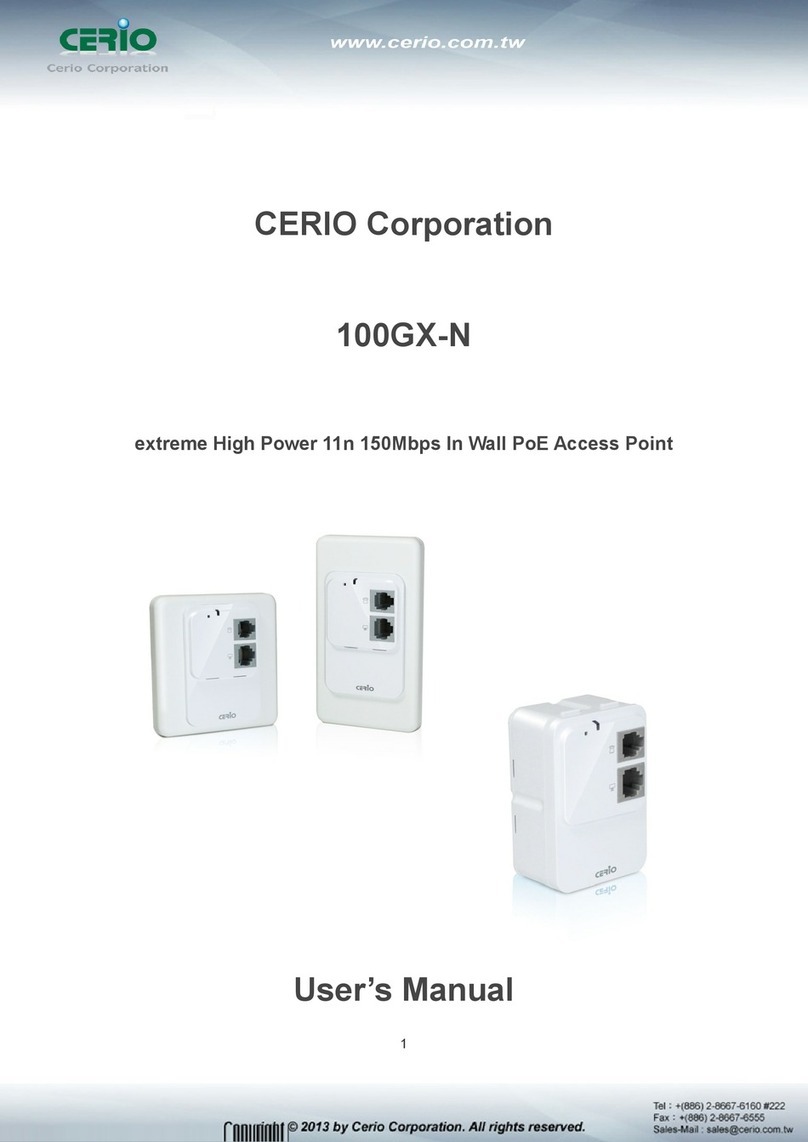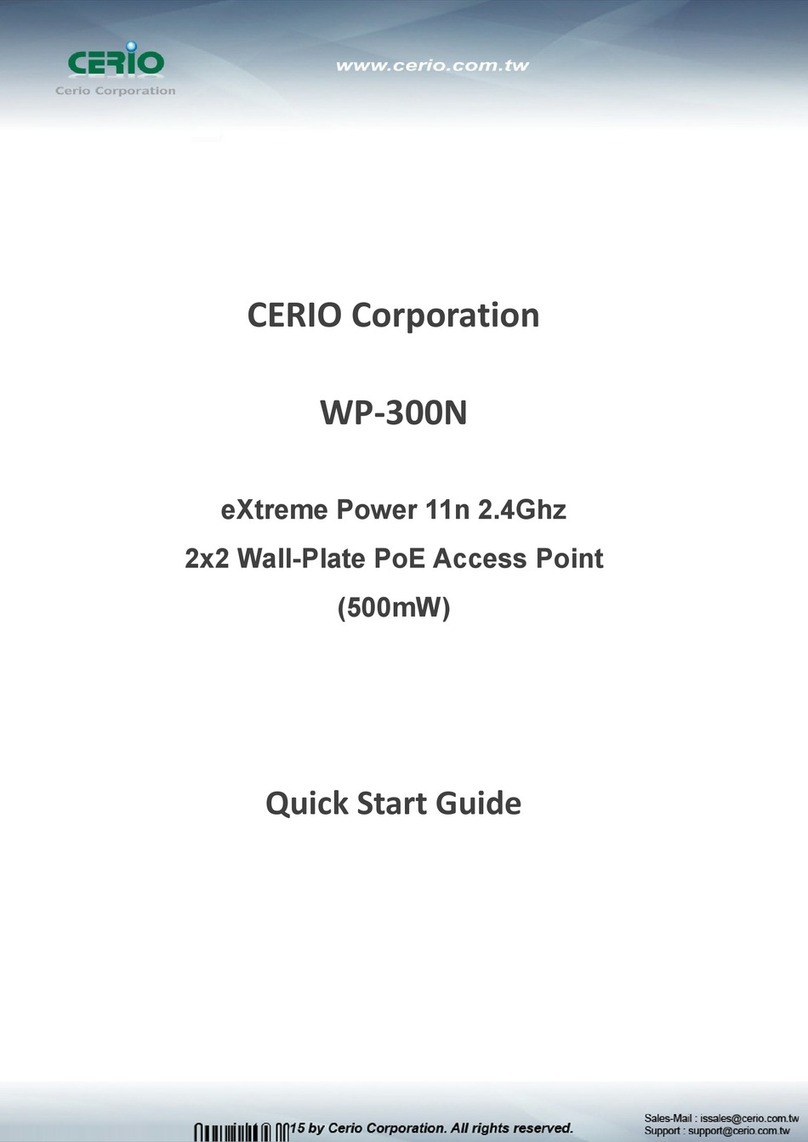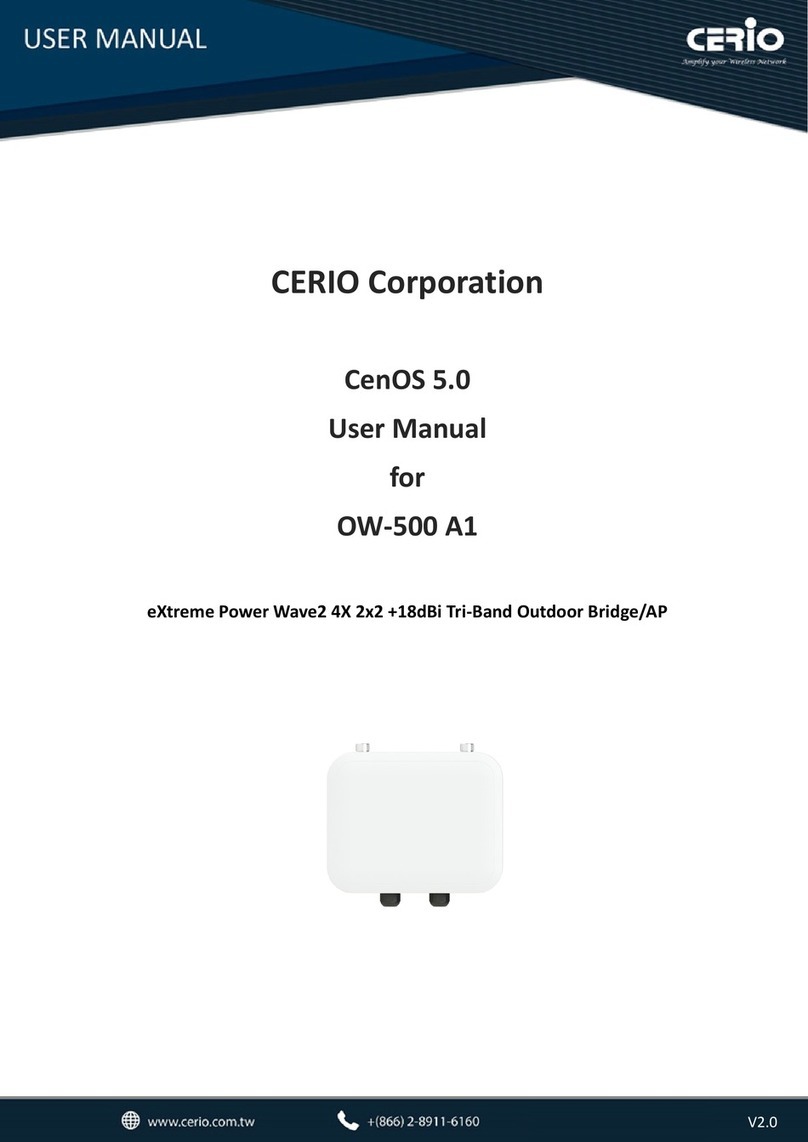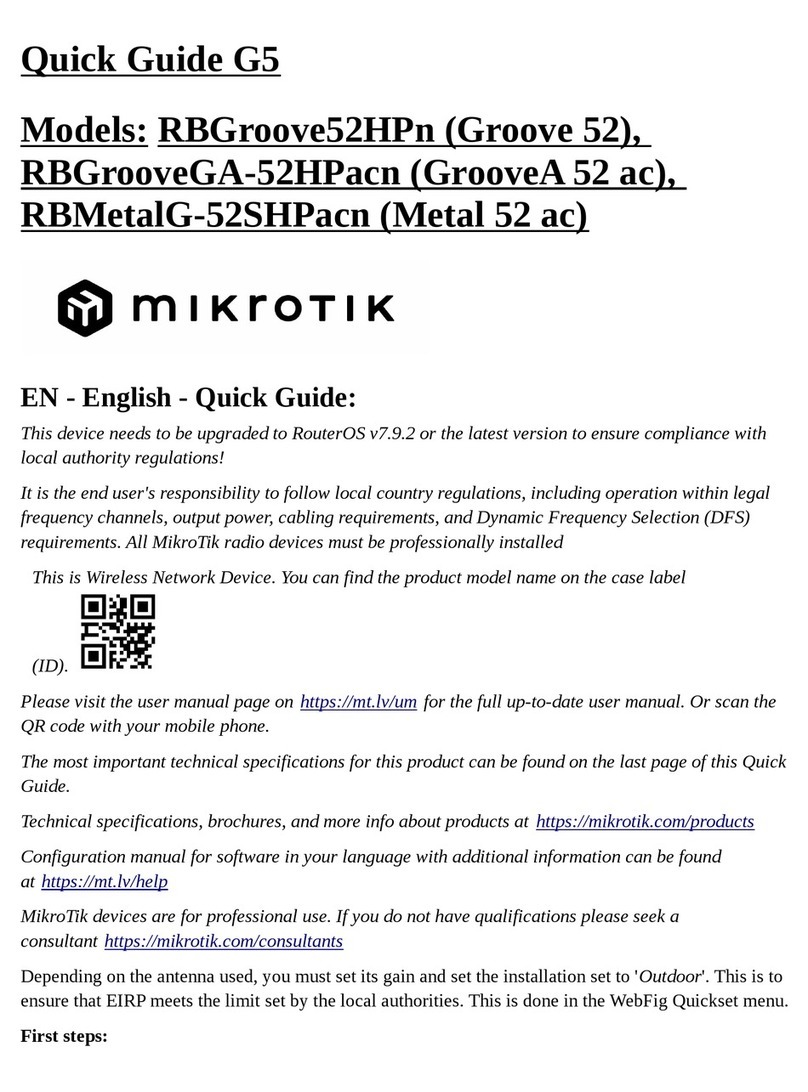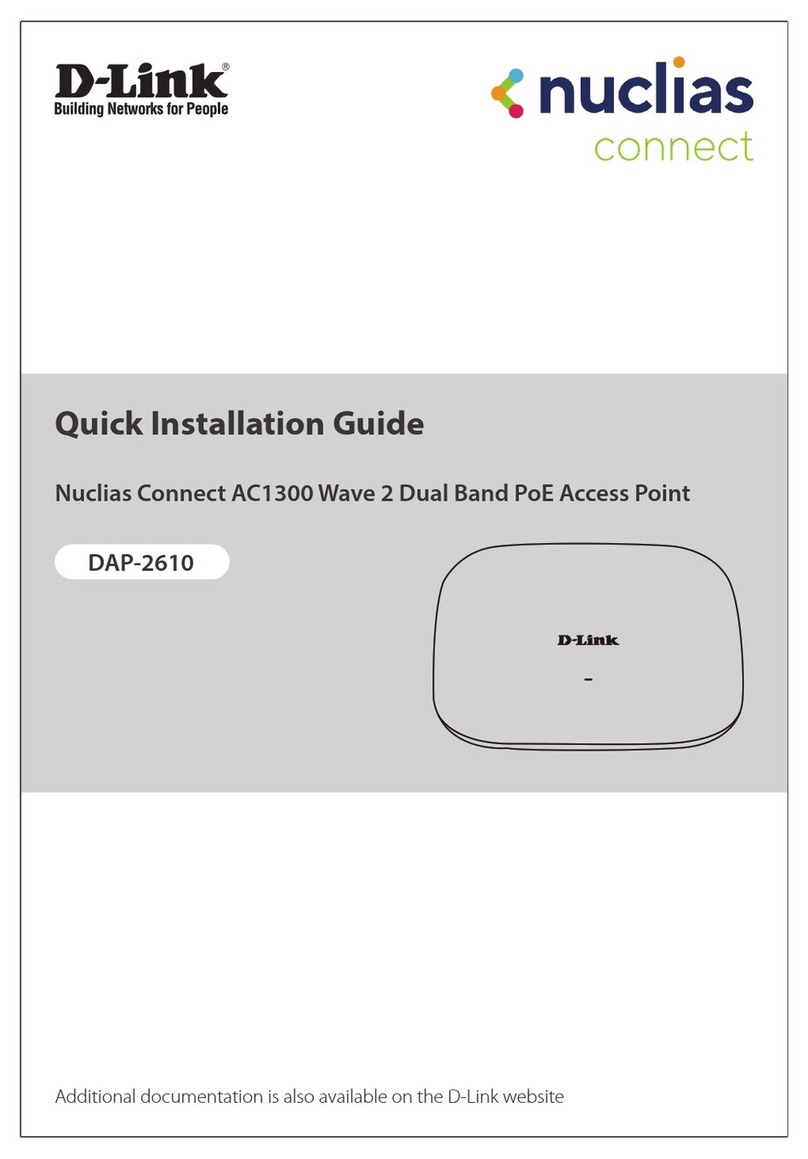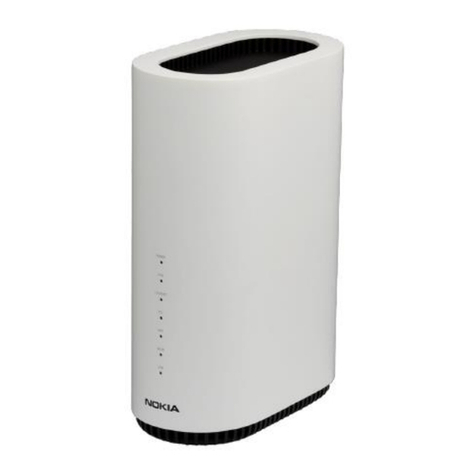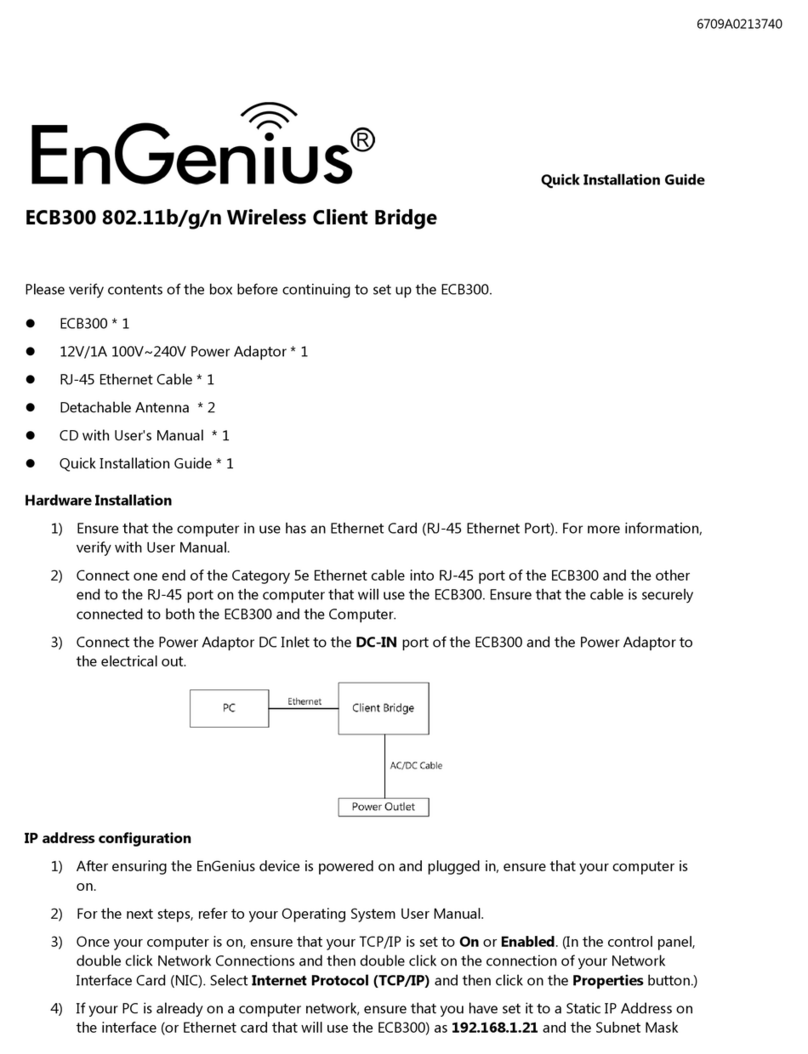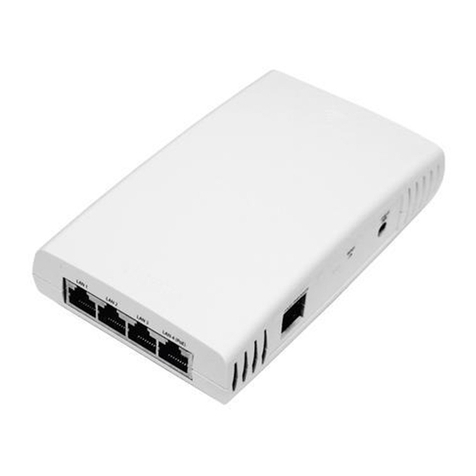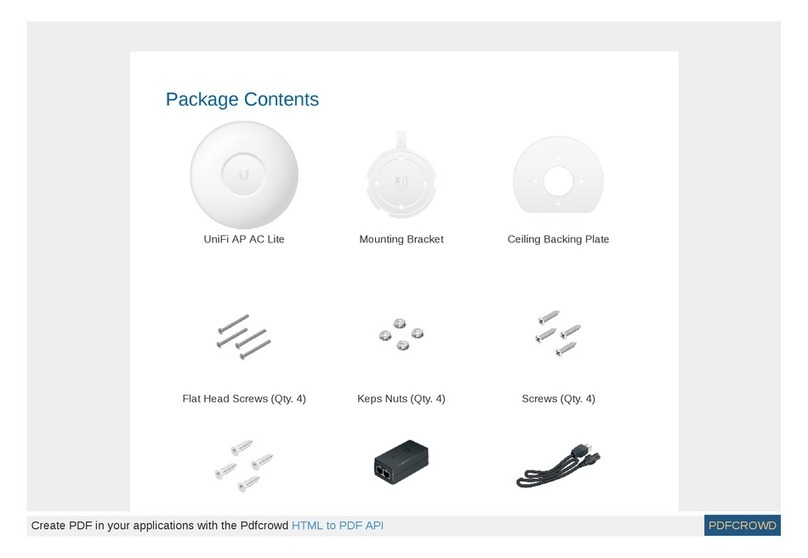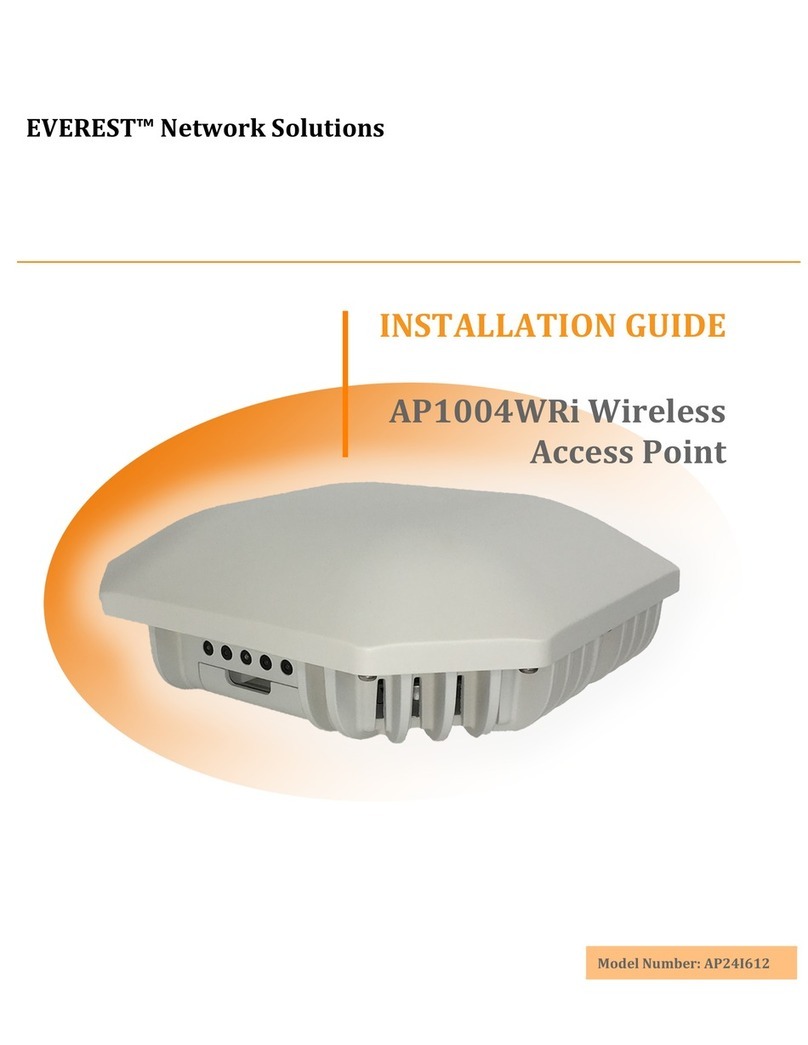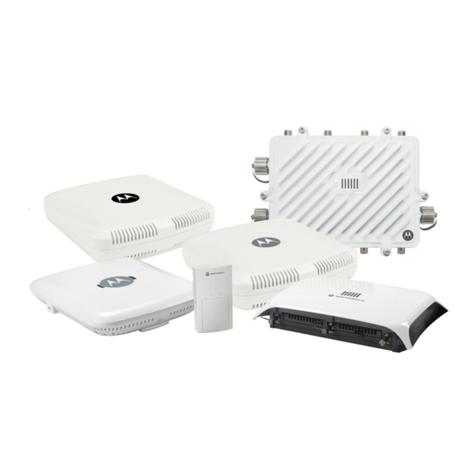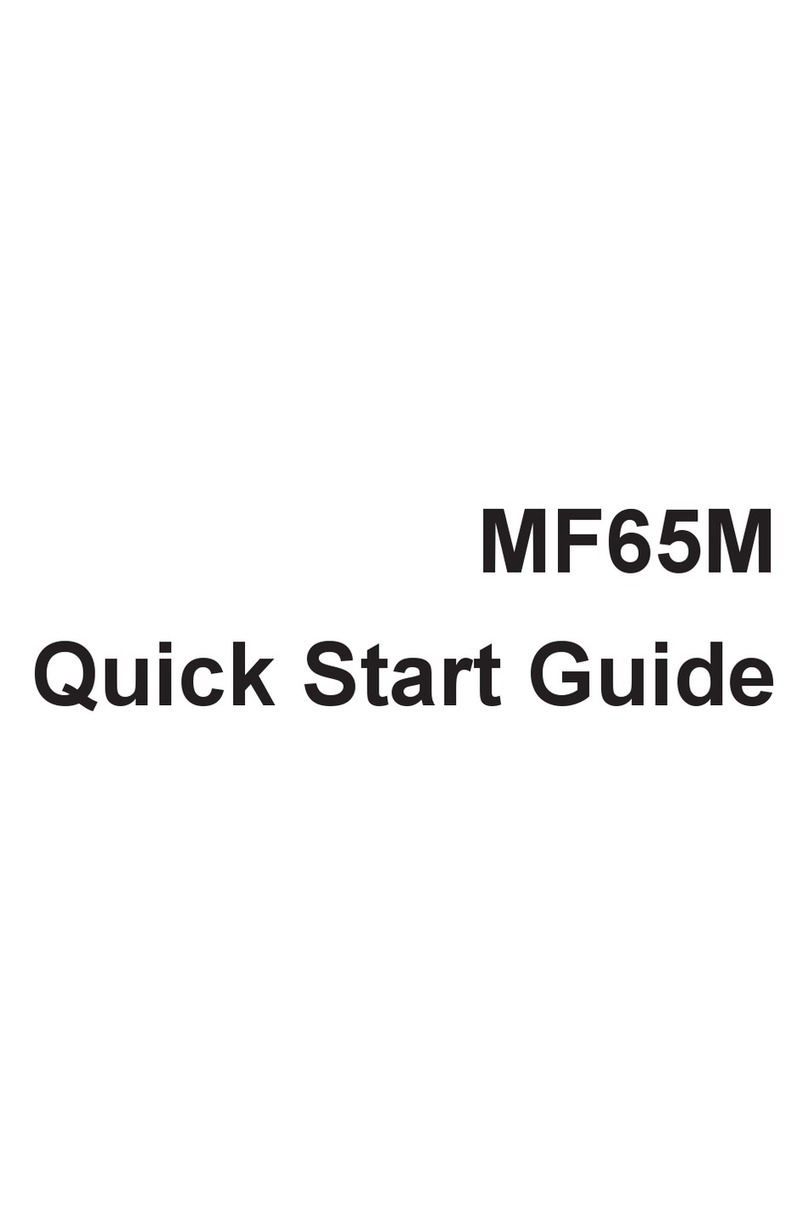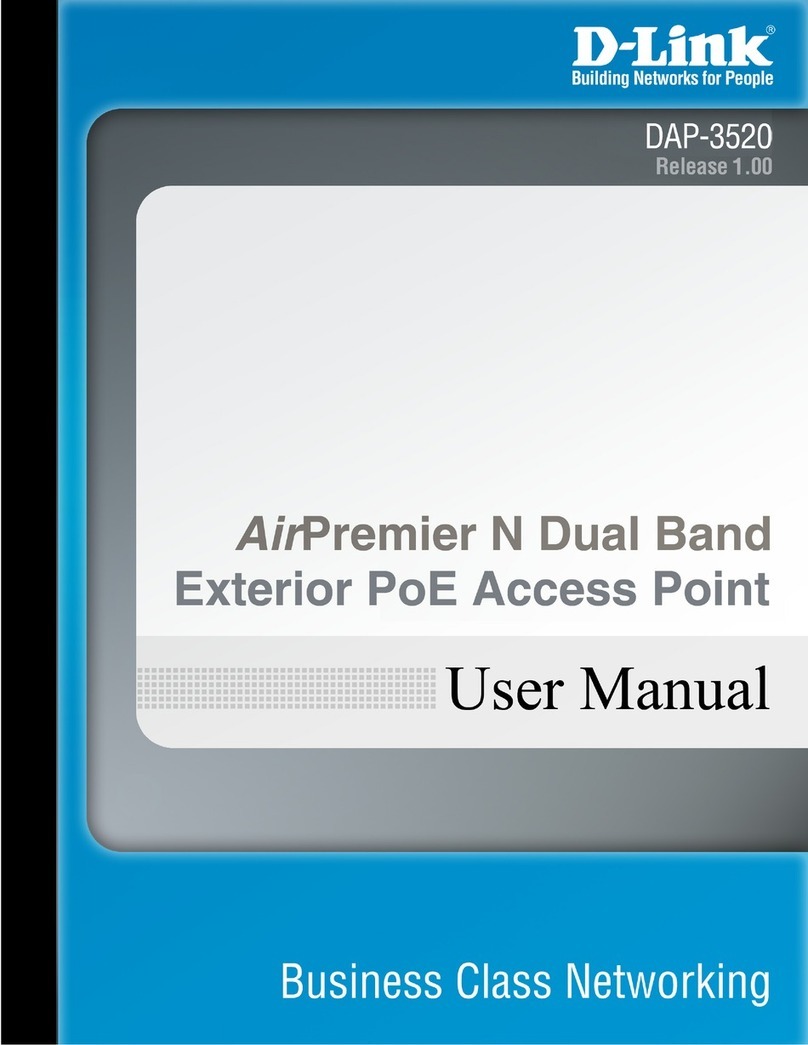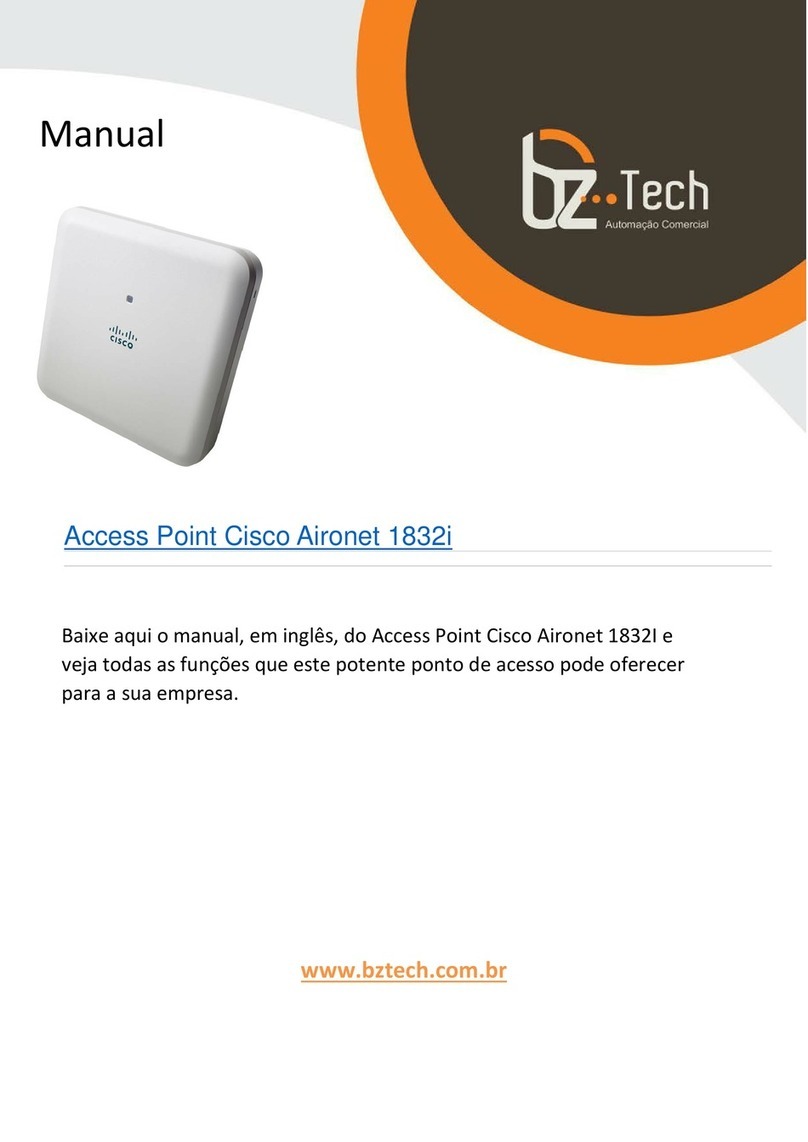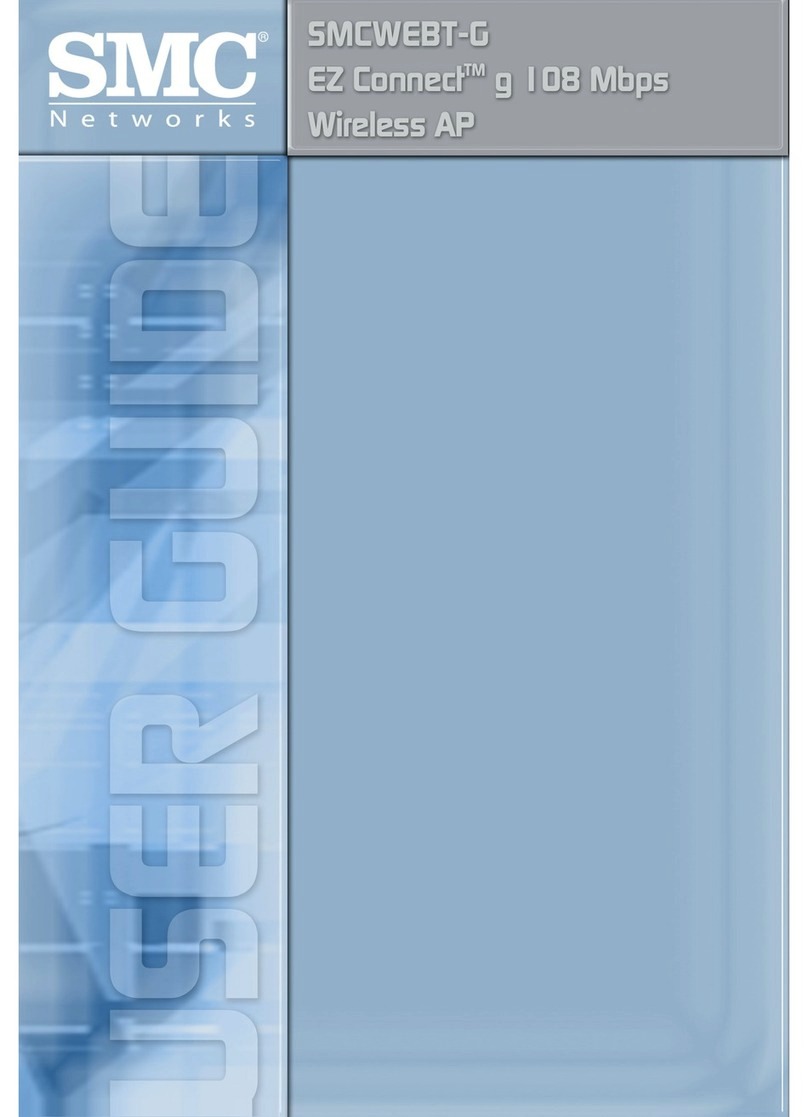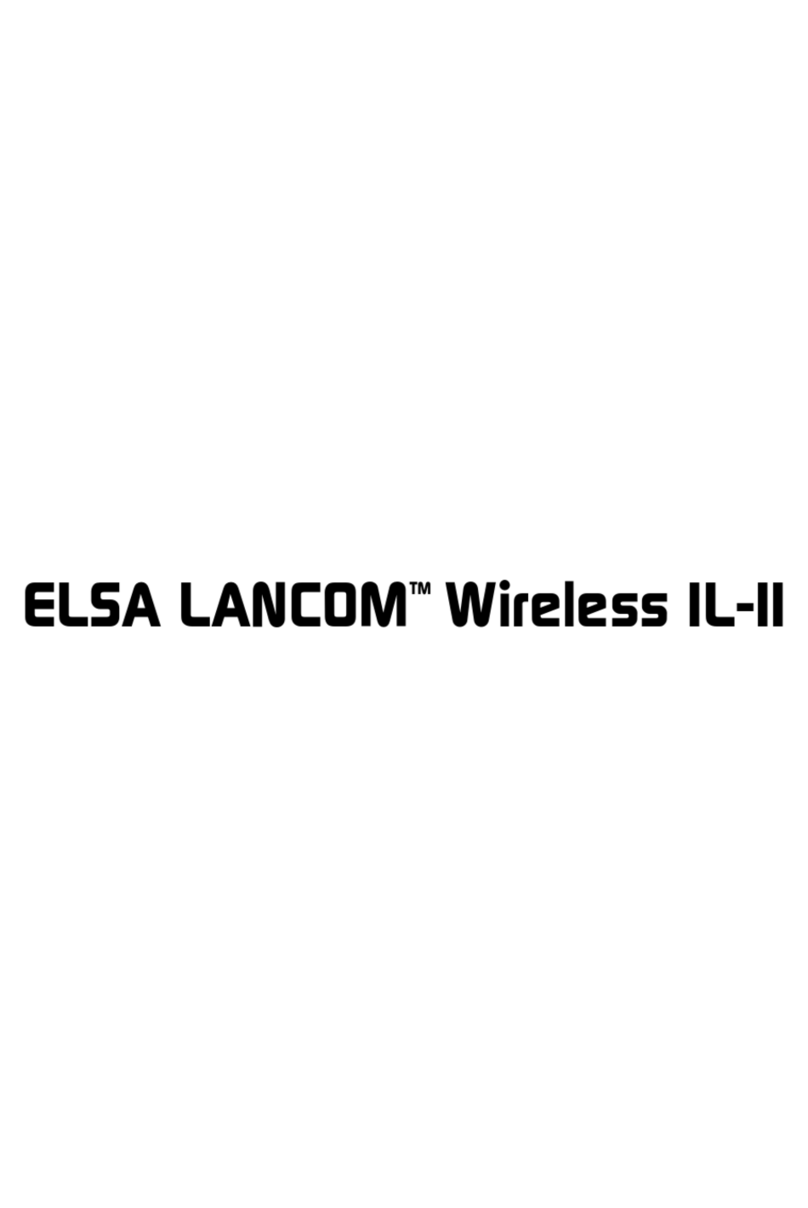Cerio CW-400NAC User manual

CERIO Corporation
CW-400NAC
eXtreme Power AC1200 2.4GHz / 5GHz 2x2 Ceiling / Wall
PoE Access Point ( 800mW )
CenOS5.0 User Manual

1. Introduction......................................................................................................................................5
1.1 Overview...........................................................................................................................5
1.2 Software Configuration.................................................................................................7
1.3 Login CW-400NAC Web Page....................................................................................11
2. Software Setting ...........................................................................................................................12
2.1 Operating Mode Introduction....................................................................................12
3. Access Point mode......................................................................................................................15
3.1 Select AP Mode.............................................................................................................15
3.2 VLAN Setup....................................................................................................................16
3.2.1 Network Button.....................................................................................................17
3.2.2 Network Pull-down menu...................................................................................18
# DHCP Server .......................................................................................................................18
# Radio 0/1 Access Point....................................................................................................20
# MAC Filter.............................................................................................................................22
# 802.11r/802.11k Fast Roaming.........................................................................................23
3.3 Authentication...............................................................................................................25
# Authentication Button:.........................................................................................................26
# Authentication Dropdown Button ......................................................................................27
3.3.1 Guest........................................................................................................................27
3.3.2 Local User...............................................................................................................28
3.3.3 OAuth2.0.................................................................................................................29
※
Sample for Google OAuth2.0 setup..................................................................29
※
Sample for Facebook OAuth2.0 setup.............................................................32
3.3.4 PoP3/IMAP Server ................................................................................................36
3.3.5 Customize Page....................................................................................................37
3.3.6 Language................................................................................................................39
3.3.7 Walled Garden.......................................................................................................39
3.3.8 Privilege Address .................................................................................................39
3.3.9 Bulk MAC Address...............................................................................................40
3.3.10 Profile.......................................................................................................................40
3.4 RADIUS Server..............................................................................................................41
3.5 Radius Account Setup ................................................................................................41
3.6 Wireless Basic Setup...................................................................................................42
3.6.1 Radio 0 Basic Setup (2.4G)................................................................................42
3.6.2 Radio 1 Basic Setup (5G)...................................................................................45
3.6.3 Advanced Setup....................................................................................................48

3.6.4 WMM Setup ............................................................................................................51
3.6.5 WDS Setup .............................................................................................................53
4. CAP Mode.......................................................................................................................................56
4.1 System VLAN Setup.....................................................................................................56
4.2 AP Control......................................................................................................................58
# Centralized ManagementAPs operating Instructions:..................................................59
4.2.1 Scan Device ...........................................................................................................59
4.2.2 Batch Setup............................................................................................................60
4.2.3 AP Setup .................................................................................................................63
4.2.4 Group Setup...........................................................................................................64
4.2.5 Map Setup...............................................................................................................64
4.2.6 Authentication Profile .........................................................................................66
5. Client Bridge Mode.......................................................................................................................67
5.1 Configure LAN Setup...................................................................................................68
5.2 Configure DHCP Setup ...............................................................................................70
5.3 Wireless General Setup..............................................................................................72
5.3.1 Radio 0(2.4G) Basic Setup.................................................................................72
5.3.2 Radio 1(5G) Basic Setup.....................................................................................74
5.3.3 Advanced Setup....................................................................................................75
5.3.4 WMM Setup ............................................................................................................78
5.3.5 Station Setup.........................................................................................................80
5.3.6 Repeater AP Setup...............................................................................................81
5.3.7 MAC Filter...............................................................................................................83
5.3.8 802.11r/802.11k Fast Roaming ..........................................................................84
6. WISP Mode.....................................................................................................................................87
6.1 Configure WAN Setup .................................................................................................87
6.2 Configure LAN Setup...................................................................................................91
6.3 Configure DHCP Server..............................................................................................91
6.4 Wireless General Setup ..............................................................................................93
6.4.1 Radio 0(2.4G) Basic Setup.................................................................................94
6.4.2 Radio 1(5G) Basic Setup.....................................................................................95
6.4.3 Advanced Setup....................................................................................................97
6.4.4 WMM Setup ..........................................................................................................100
6.4.5 Station Setup.......................................................................................................102
6.4.6 Repeater AP Setup.............................................................................................103
6.4.7 MAC Filter.............................................................................................................105
6.4.8 802.11r/802.11k Fast Roaming ........................................................................106
6.5 Configure Advanced Setup......................................................................................108

6.5.1 DMZ ........................................................................................................................108
6.5.2 IP Filter ..................................................................................................................109
6.5.3 MAC Filter.............................................................................................................110
6.5.4 Virtual Server.......................................................................................................111
6.5.5 Access Control....................................................................................................113
6.5.6 Time Policy...........................................................................................................114
7. Router Made.................................................................................................................................116
7.1 Configure WAN Setup ...............................................................................................116
7.2 Configure LAN Setup.................................................................................................120
7.2.1 Network Button...................................................................................................121
7.2.2 Network Pull-down menu.................................................................................122
# DHCP Server .....................................................................................................................122
# Radio 0/1 Access Point..................................................................................................123
# MAC Filter...........................................................................................................................126
# 802.11r/802.11k Fast Roaming.......................................................................................127
7.3 Wireless Basic Setup.................................................................................................129
7.3.1 Radio 0 Basic Setup (2.4G)..............................................................................129
7.3.2 Radio 1 Basic Setup (5G) .................................................................................132
7.3.3 Advanced Setup..................................................................................................135
7.3.4 WMM Setup ..........................................................................................................137
8. System Management.................................................................................................................140
8.1 Configure system management .............................................................................140
8.2 Configure Time Server..............................................................................................142
8.3 Control PoE Bridge....................................................................................................143
8.4 Configure SNMP Setup.............................................................................................143
9. Utilities...........................................................................................................................................144
9.1 Profile Setting..............................................................................................................144
9.2 System Upgrade .........................................................................................................146
9.3 Network Utility.............................................................................................................147
9.4 Reboot...........................................................................................................................147
10. Status.....................................................................................................................................148
10.1 Overview.......................................................................................................................148
10.2 Wireless Client............................................................................................................148
10.3 Online Users by Captive Portal...............................................................................149
10.4 Authentication Log.....................................................................................................150
10.5 System Log ..................................................................................................................150

1. Introduction
1.1 Overview
The CW-400NAC eXtreme Power AC1200 2.4GHz / 5GHz 2x2 Ceiling / Wall PoE Access Point
is an AC1200 Wireless concurrent dual band wifi device. CW-400NAC bundles Cerio CenOS
5.0 Software Core with Built-in CAP (controller-less AP) mode. The CAP mode can centralize
management of up to 128 units of CW-400NAC AP. Paired with our new CenOS 5.0 software,
CW-400NAC also supports Access Point Mode (AAP Mode with built-in 802.1x RADIUS Server),
Client Bridge+ Repeater Mode, and WISP Repeater Mode (to extend the coverage of an existing
network). This device is perfect for enterprise deployment such as corporate offices, public venues,
conferences, and other high traffic indoor environments.
The CW-400NAC eXtreme Power AC1200 2.4GHz / 5GHz 2x2 Ceiling / Wall PoE Access Point
hardware utilizes 800mW (2.4GHZ) / 500mW (5GHZ) eXtreme power and 4 Omni directional
antennas (2 x 2.4GHz & 2 x 5GHz ). CW-400NAC supports safe ceiling and wall mounting through
its mounting bracket lock design. Users must use a thin tool to properly remove the device from its
installation location, which ultimately reduces device theft as well as damage. CW-400NAC’s 11ac
chipset design provides enterprise grade CPU performance, allowing the device to handle up to 100
concurrent clients. This 11ac dual-band AP hardware also includes 802.3af PoE capabilities that
allows power and data to be supplied to the unit using CAT5 Ethernet cable. CW-400NAC many
advanced software features, including our Cerio PoE Bridge function, which allows the device to
provide PoE power to subsequent devices such as IP Cams
CenOS 5.0 combines aspects of CenOS 3.0 and CenOS 4.0 cores. Supported operation modes
include Access Point Mode (including Authentication AP [AAP] Mode, Pure AP Mode, and AP with
WDS Mode), Control Access Point [CAP] (Centralized AP Controller), Router AP Mode, Client
Bridge + Repeater Mode, and finally WISP / CPE Repeater + AP Mode. (CW-400NAC does not
support Router AP Mode)
CenOS 5.0’s AAP mode includes new features such as built-in 802.1x RADIUS authentication
support. ThroughAAP and CAP Mode, wireless clients can be securely authenticated through a
customized login page that supports OAuth2.0 credentials (Facebook Login, Google Login, etc).
This opens up network access conveniently to users, while simultaneously maintaining network
security and network management.

Administrators can use CenOS 5.0 CAP Mode to centrally manage AAP devices within the same
network. Using CAP Mode’s Batch Setup, administrators can make setting changes such as:
Wireless Settings, Security Settings / User Authentication / Firmware Upgrade / System Time /
Traffic Monitoring / Status Overview and more. CAP Mode also allows users to limit client access
and bandwidth to effectively load balance the network.
Cerio’s innovative AAP design allows users to create customized login pages (Captive Portal) for
user authentication. This not only provides a platform for marketing, but also provides a security
barrier by allowing clients to use third-party credentials such as Facebook and Google to login into
the network. Using only the customized login page for authentication deviates from traditional
security encryptions, which actually slow bandwidth speeds by up to 20%.

1.2 Software Configuration
CW-400NAC supports web-based configuration. Upon the completion of hardware installation,
CW-400NAC can be configured through a PC/NB by using a web browser such as Internet Explorer
6.0 or later.
Default IP Address: 192.168.2.254
Default Subnet Mask: 255.255.255.0
Default Username and Password
MODE AP , Client Bridge , WISP Mode
Management Account Root Account
Username
root
Password default
IP Segment Set-up for Administrator's PC/NB
Set the IP segment of the administrator's computer to be in the same range as CW-400NAC for
accessing the system. Do not duplicate the IPAddress used here with IPAddress of CW-400NAC
or any other device within the network.
Example of Segment: (Windows XP)
Click Start -> Settings -> Control Panel, and then “Control Panel” window appears.
Click on “Network Connections”, and then “Network Connections” window appears.
Click right on “Local Area Connection”, and select Properties.
PC link to device setup by OS Windows7
Please PC link to Device used cat5/6 Ethernet cable.

Step 1 :
Please click on the computer icon in the bottom right window, and click “Open Network
and Sharing Center”
Step 2 :
In the Network and Sharing Center page, Please click on the left side of “Change adapter
setting” button
1
2

Step 3 :
In “Change adapter setting” Page. Please find Local LAN and Click the right button on
the mouse and Click “Properties”
Step 4 :
In “Properties” page, please Click “Properties” button to TCP/IP setting

Step 5 :
In Properties page to setting IP address, please find “Internet Protocol Version 4
(TCP/IPv4)” and double click or click “Install” button.
Step 6 :
Select “Use the following IP address”, and fix in IPAddress : 192.168.2.#
ex. The # is any number by 1 to 253
Subnet mask : 255.255.255.0
And Click "OK" to complete the fixed computer IP setting
Double click

Please Open Web Browser
Without a valid certificate, users may encounter the following problem in IE7 when they try
to access system's WMI (https://192.168.2.254). There will be a “Certificate Error”, because
the browser treats system as an illegal website.
1.3 Login CW-400NAC Web Page
Launch Web Browser
Launch as web browser to access the web management interface of system by entering the default
IPAddress, http://192.168.2.254, in the URL field, and then press Enter.
System Login
Please use default Users name: “root” and default password “default” to login.

2. Software Setting
2.1 Operating Mode Introduction
CERIO CW-400NAC eXtreme Power 11n Dual Band 2x2 Ceiling / Wall PoE Access Point
with CenOS5.0 software supports four operational modes: Access Point Mode, Control
Access Point Mode, Client Bridge Mode, and WISP Mode. It utilizes built-in remote
management features that simplify deployment and reducecosts of continued maintenance of
the access point
Because of CW-400NAC’s Dual Band capabilities, this device possesses more reliable
connectivity and allows for higher capacity and performance speeds. CW-400NAC can operate
concurrently on two radio frequencies, simultaneously enabling more flexible deployment without
sacrificing bandwidth or risking device overloading. These high performance and high loadbearing
capabilities makes CW-400NAC the perfect device to be deployed in Offices, Hotels, Universities,
Hospitals, Airports, Luxury Houses, etc.
CAP mode (Centralizes Access Point)
Control Management of CenOS5.0 APs (x128 APs)
AP Management support 802.1Q VLAN infrastructure
Centralized setting Access Point function and firmware upgrade.
APs Group management for concept.

Access Point Mode (Supports AP+WDS Mode)
It can be deployed as a traditional fixed wireless Access Point
It allow wireless clients or Stations ( STA ) to access
Supports DHCP Service, allowing for automated assigning of IP addresses to clients connecting
to the network
WDS Setup includes AES (Advanced Encryption Standard) Authentication
This enables the wireless interconnection of Access Point in a IEEE802.11 network and accepts
wireless

Client Bridge + Repeater Mode
It can be used as a Client Bridge + Repeater AP to receive wireless signals over last mile
applications, helping WISPs deliver wireless broadband Internet service to new residential and
business customers
In this mode, CW-400NAC is enabled with DHCP Server functions. The wired clients of
CW-400NAC are in the same subnet from Main Base Station and it accepts wireless
connections from client devices. You can disabled the repeater extending AP function, which
will enable the “AP Client ” function
If client bridge used 5Ghz band the Repeater AP only used 2.4Ghz band.
WISP + Repeater AP Mode
It can be used as an WISP/Outdoor Customer Premises Equipment (CPE) to receive wireless
signals over last mile application, helping WISPs deliver wireless broadband Internet service to
residents and business customers
In the WISP (CPE) mode, CW-400NAC is a gateway enabled with NAT and DHCP Server
functions. The wired clients connected to DT-300N are in different subnet from those
connected to Main Base Station, and, in WISP (CPE) mode, it does not accept wireless
association from wireless clients.

3. Access Point mode
When AP mode is chosen, the system can be configured as an Access Point. This section provides
detailed explanation for users to configure in the AP mode with help of illustrations. In the AP mode,
functions listed in the table below are also available from the Web-based GUI interface.
3.1 Select AP Mode
The system administrator can set the desired mode via this page, and then configure the system
according to their deployment needs.
When select Authentication AP mode, administrator can use Hotspot Portal function.
Please click on System -> Mode Setup and follow the below setting.

3.2 VLAN Setup
Here are the instructions to setup the local IPAddress / Netmask / Gateway / DNS and management
Access Point 2.4G or 5G Radio on/off. Administrators can change settings such as LAN Spanning
Tree and Tag VLAN functions.
VLAN Mode
:
Display on/off for the VLAN network.
Flag
:
Display master VLAN and VLAN Tag No. information.
IP Address
:
Display IP Address for VLAN Network.

NetMask
:
Display IP netmask.
Radio 0
:
Display radio 2.4G SSID name.
Radio 1
:
Display radio 5G SSID name.
Action
:
The button can set VLAN network functionsand radio functions.
3.2.1 Network Button
Administrator can click button to set VLAN network functions.
VLAN Mode
:
Administrator can select Enable or disable for the VLAN Network.
At least one VLAN will always be enabled by default
IP Mode
:
Administrator can select enable or disable function for VLAN IP.
IP Address/ NetMask
:
Administrator can set IP address and netmask for the VLAN.
Management
Access Point 0
:
Administrator can Enable or Disable 2.4G Radio.
Access Point 0
:
Administrator can Enable or Disable 2.4G Radio.
802.1d Spanning Tree : The spanning tree network protocol provides a loop free topology
for a bridged LAN between LAN interface and 8 WDS interfaces from wds0 to wds7. The
Spanning Tree Protocol, which is also referred to as STP, is defined in the IEEE Standard
802.1d

Control Port
:
Administrator can select one of the VLAN as managed AP.
IAPP
:
Administrator can select radio 2.4G or 5G for IAPP roaming.(the IAPPcondition must
use WPA2-PSK Wi-Fi security and AES algorithm)
3.2.2 Network Pull-down menu
Administrator can set DHCP Server and 2.4/5G security for the access point and set 802.11r fast
roaming.
Please click pull-down button.
# DHCP Server
Administrator can select enable / disable the function

Start IP : Set Start IP for DHCP Service.
End IP : Set End IP for DHCP Service.
Netmask: Set IP Netmask, the default is 255.255.255.0
Gateway: Set Gateway IP for DHCP Service.
DNS(1-2) IP : Set DNS IP for DHCP Service.
WINS IP : Enter IP address of the Windows Internet Name Service (WINS) server; this is
optional.
Domain : Enter the domain name for this network.
Lease Time : The IP addresses given out by the DHCP server will only be valid for the
duration specified by the lease time. Increasing the time ensure client operation without
interruptions, but could introduce potential conflicts. Lowering the lease time will avoid
potential address conflicts, but might cause more interruptions to the client while it will acquire
new IP addresses from the DHCP server. Default is 86400 seconds
DHCP Client List
Administrator can view IP address used status of client users on each DHCP Server.
Static Lease IP Setup
Administrator can set be delivered fixed IP address to the users.
Comment : Enter rule description.
IP Address : Enter access point IP.
MAC Address : Enter Client MAC Address of PC network.

# Radio 0/1 Access Point
Administrator can Enable or Disable radio 0/1 (2.4/5G) Wi-Fi, if enable radio 0/1 (2.4/5G)
administrator can set SSID and security for the 2.4/5G access point.
Access Point: Administrator can Enable or Disable the radio 0 (2.4G).
ESSID: Administrator can set Wi-Fi SSID name for the 2.4G.
SSID Visibility: Administrator can select Enable or Disable the Visibility.
Client Isolation: Enable or Disable the client isolation function.
Connection Limit: Administrator can select Enable or Disable WiFi connection Limit.
User Limit: If select enable of the connection Limit function, administrator can set users
connection limit.
Authentication: Select the desired security type from the drop-down list; the options are
WPA-PSK, WPA2-PSK, WPA/WPA2-Enterprise and WEP 802.1X.
Open System: Data is not unencrypted during transmission when this option is
selected.
WPA/WPA2 Personal: WPA/WPA2 is short for W-Fi Protected Access-Pre-Shared
Key. WPA/WPA2 uses the same encryption way with WPA, and the only difference
between them is that WPA/WPA2 recreates a simple shared key, instead of using the
user’s certification.
Other manuals for CW-400NAC
2
Table of contents
Other Cerio Wireless Access Point manuals
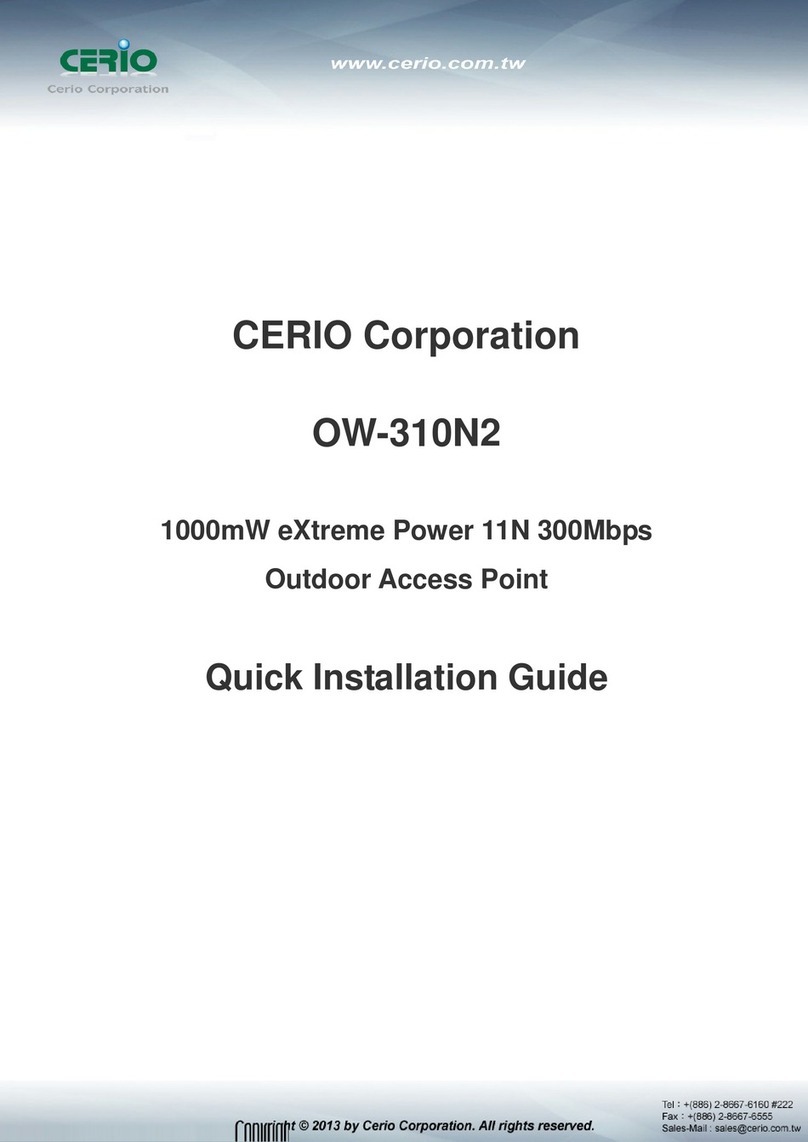
Cerio
Cerio ow-310n2 Operator's manual
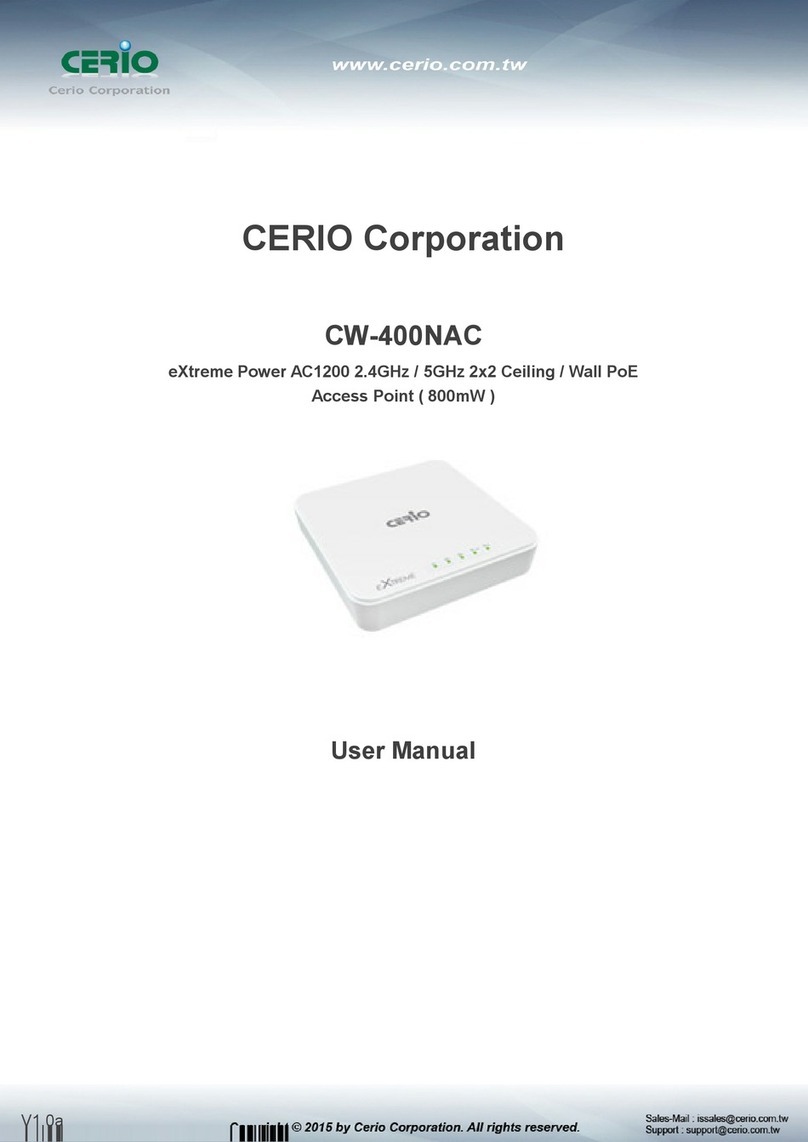
Cerio
Cerio CW-400NAC User manual

Cerio
Cerio CW-400NAC User manual
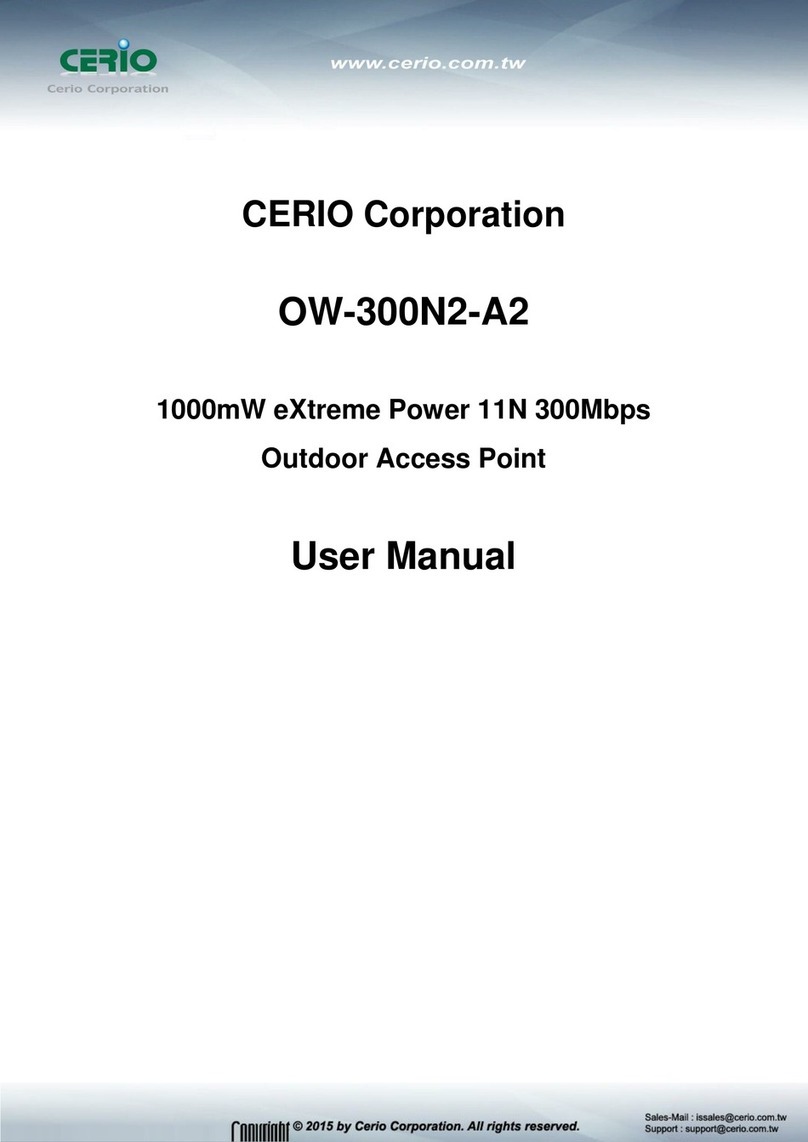
Cerio
Cerio OW-300N2-A2 User manual
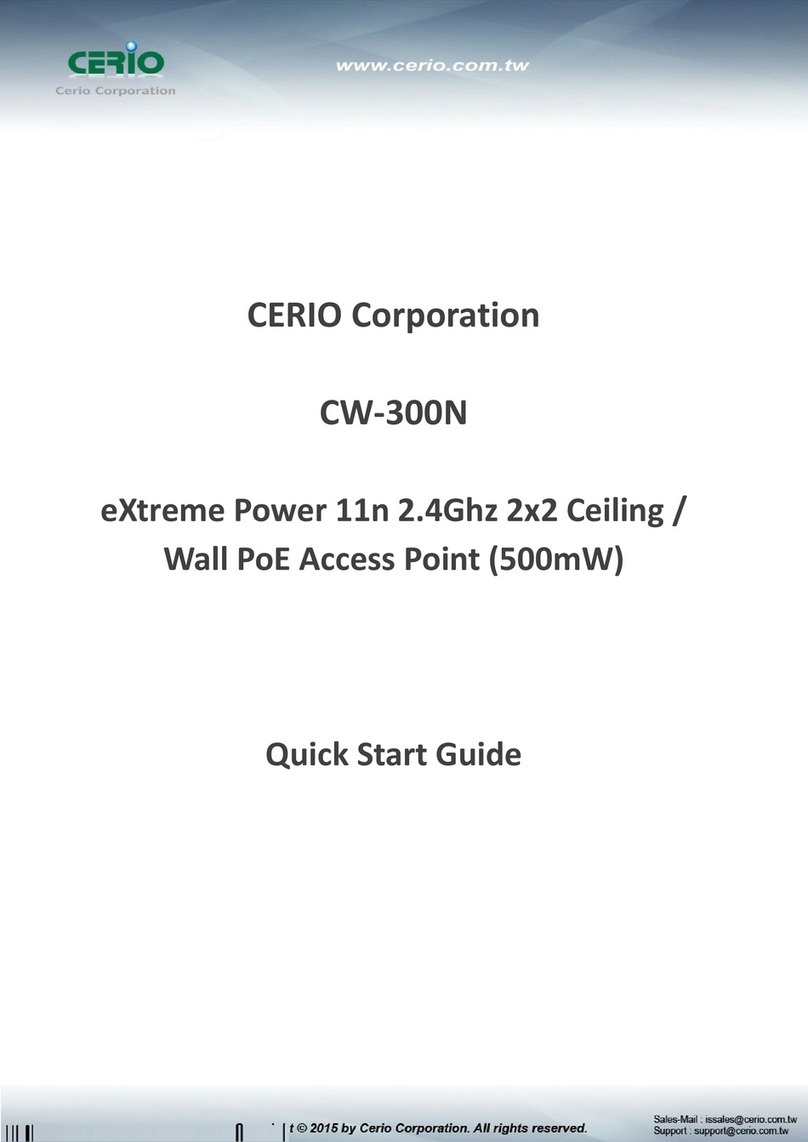
Cerio
Cerio CW-300N User manual
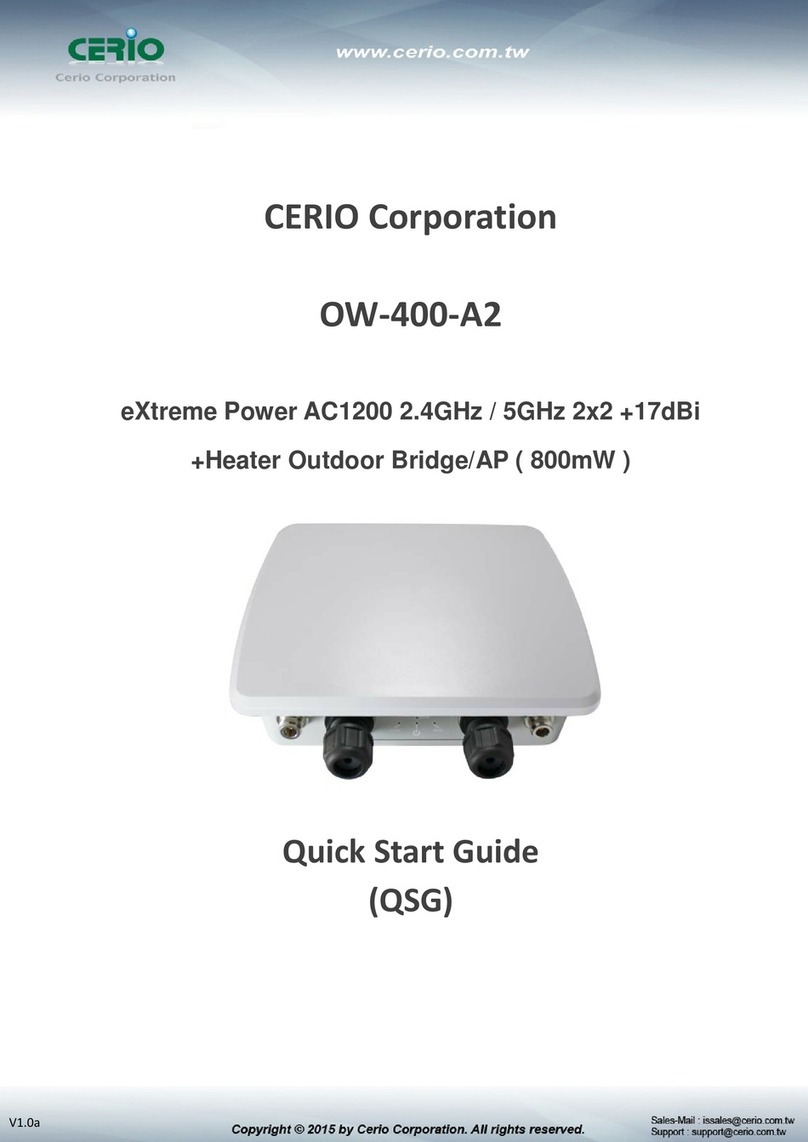
Cerio
Cerio OW-400-A2 User manual
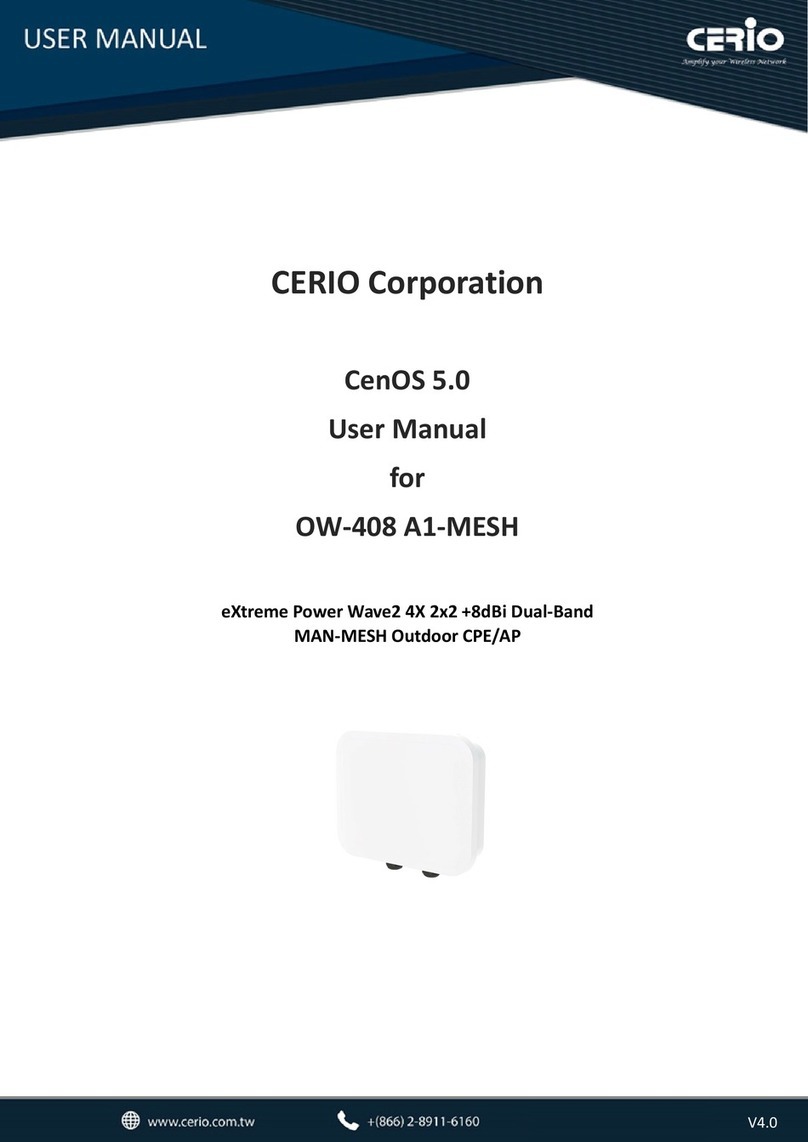
Cerio
Cerio eXtreme OW-408 A1-MESH User manual
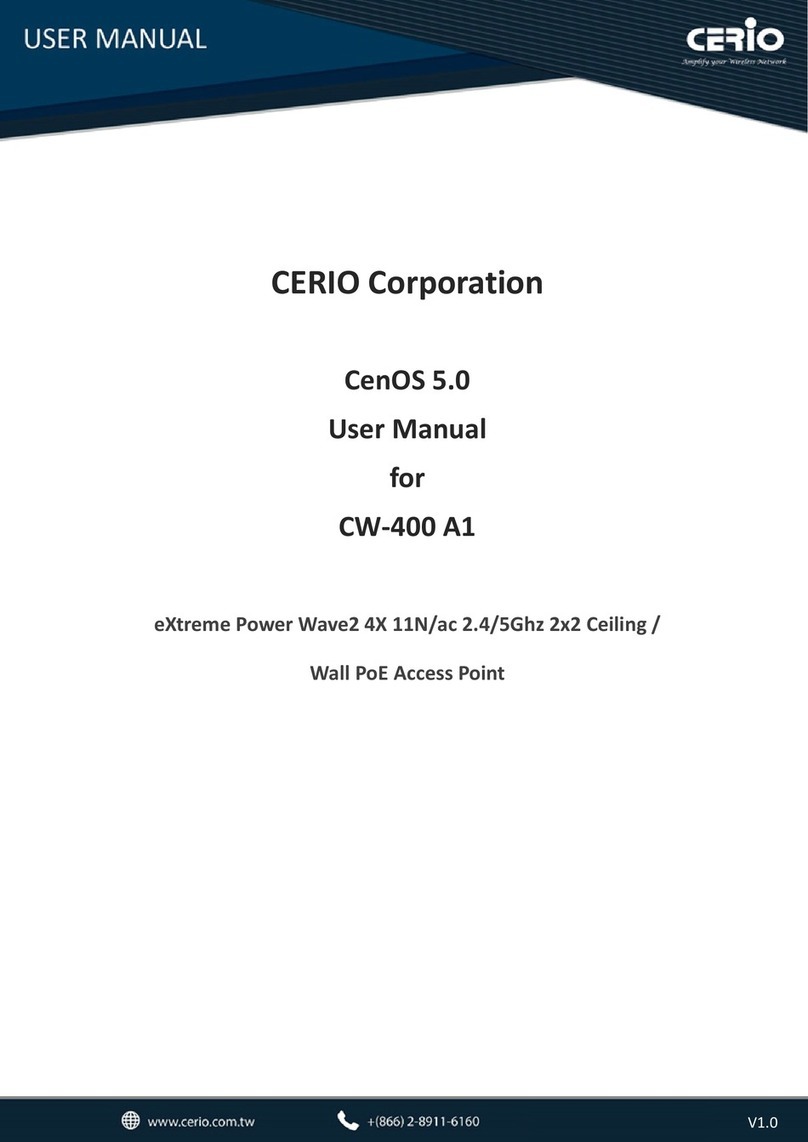
Cerio
Cerio eXtreme CW-400 A1 User manual

Cerio
Cerio OW-300N2-A2 User manual
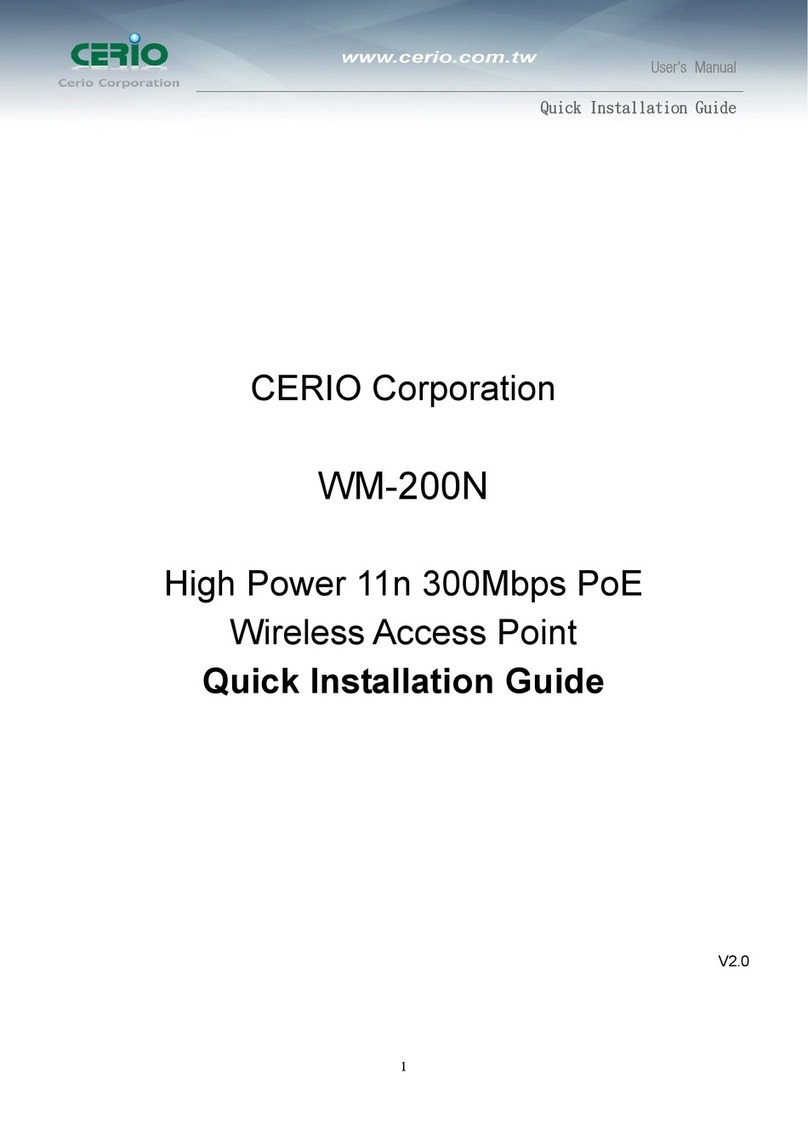
Cerio
Cerio WM-200N User manual

